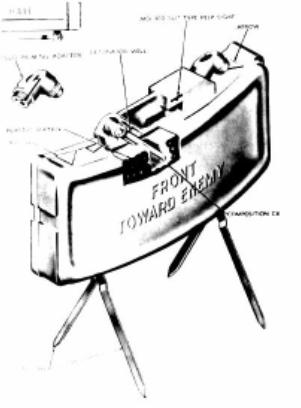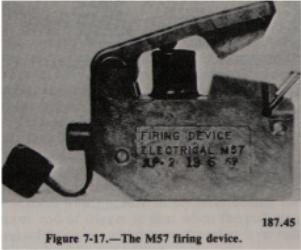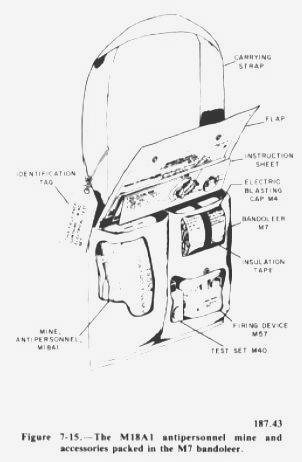M18A1 Claymore Mine
 The M18A1 Claymore mine is used as an
electrically-controlled, one-shot weapon. It is used in support of other
weapons employed in a unit's final protective fires. The M18A1 Claymore mine is used as an
electrically-controlled, one-shot weapon. It is used in support of other
weapons employed in a unit's final protective fires.
It is a directional, fragmentation antipersonnel mine, designed primarily for use against massed infantry attacks. It has:
The mine weighs a little over 3 pounds, consisting of 1 1/2 pounds of Composition C4 explosive, plus steel sphere projectiles. When detonated, the M18A1 mine projects steel fragments over a 60-degree, fan-shaped pattern approximately 6 feet high and 50 meters wide, at a range of 50 meters. This pattern of distribution is very effective up to 50 meters, moderately effective to 100 meters, and dangerous out to 250 meters. One mine and its' accessories are carried in the M7 bandoleer. Attached to the flap of the bandoleer are complete written instructions for installing, arming, testing, and firing the mine. It is strongly recommended that if at all possible, you read the directions before using the mine. To Arm the Mine:
To Fire the Mine:
Helpful Tips on Claymore Mines:
|
From Operational Medicine 2001: Health Care in Military Settings
CAPT Michael John Hughey, MC, USNR
NAVMED P-5139
January 1, 2001
Bureau of Medicine and
Surgery,
Department of the Navy,
2300 E Street NW,
Washington, D.C,
20372-5300
United States Special Operations Command,
7701 Tampa Point Blvd.,
MacDill AFB, Florida,
33621-5323
Home · Textbooks and Manuals · Videos · Lectures · Distance Learning · Training · Operational Safety · Search
This website is dedicated to the development and dissemination of medical information that may be useful to those who practice Operational Medicine. This website is privately-held and not connected to any governmental agency. The views expressed here are those of the authors, and unless otherwise noted, do not necessarily reflect the views of
the Brookside Associates, Ltd., any governmental or private organizations. All writings, discussions, and publications on this website are unclassified.
© 2006 Medical Education Division, Brookside Associates, Ltd. All rights reserved
 Take cover at the firing position.
Take cover at the firing position. To Disarm the Mine:
To Disarm the Mine: